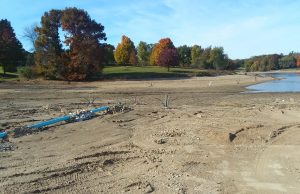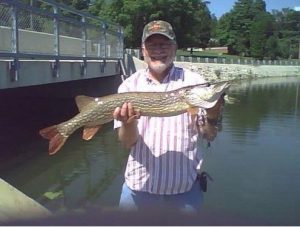Eureka Lake project progressing as city looks to document fish population
By Holly Eaton For Chronicle Media — November 7, 2018
Earlier this month, City of Eureka Public Works Director Rusty Klaus and his crew built more than a dozen fish habitats, and installed them recently in strategic, fish-friendly places around the lake. (Photo by Holly Eaton/for Chronicle Media)
There may be no “fish whistle” or the means to part the waters like Moses to see where all the fish are, but fishing fans may want to take photos at Eureka Lake before it fills back up.
City of Eureka Public Works Director Rusty Klaus and his crew built more than a dozen fish habitats, and installed them recently in strategic, fish-friendly places around the lake.
“The habitats, they’re just man-made structures, made of PVC pipe to encourage coverage for the fish,” city administrator Melissa Brown said. “It helps in breeding and, apparently, they’re better than trees, because they don’t catch fishing lines.”
There still are number of felled trees, large branches and some old barrels resting in the lake bed, which also attract fish. Most of them may still be visible, though the lake is beginning to fill with water.
“We’d like to document where everything is. An alderman took photos of the lake while it was down,” Brown said. “We’re thinking of getting documentation with a drone camera.”
Eureka Mayor Scott Zimmer has been keeping an eye on the progress at Eureka Lake as it continues to fill with water.

Fisherman George Baumann poses with a catch he made from Eureka Lake a few years ago. City of Eureka manager Melissa Brown said the city is hoping Eureka Lake will regain the reputation it once had for being one of the region’s “best fishing holes.” (Photo courtesy of George Baumann)
“The lake is always a story, everybody’s interested in what’s happening there,” he said. “You can see, the blue pipes are for an emergency, but others coming up out of the ground are the fish structures. A lot of the time, you’ll be fishing and trying to find the downed trees, so we’ve had a lot of fisherman out here taking videos and pictures.”
Along with habitats, city workers also created additional fishing areas for people to place chairs and fish comfortably. New white rock beds have been put in places to prevent foot traffic.
Brown said the city is hoping to renew the great reputation Eureka Lake once had before the carp infestation that caused the recent draw down.
“We hope it really reestablishes Eureka Lake as a well-known fishing spot,” she said. “The carp really caused a lot of problems, but now that the problem is cleared up we’ll have a good fish population.”
Rotone, a root-based compound that kills fish, was added late this summer, and it has now lost its efficacy. The Illinois Department of Resources recently stocked the west end of the lake with catfish. Later, they’ll add Panfish breeds and, in spring, the bass will be brought in.
Chances are, bass will be on a catch-and-release policy for a year or two, so they can grow and populate the lake. There may be some additional bans, Brown said, simply to ensure the successful re-population of fish.
In the meantime, IDNR fisheries biologist Rob Hilsabeck explained cautions residents against introducing any species of fish to the lake.
“Please don’t do us any favors. We like to start out with fish of the same size, and introducing other fish interferes with their growth rate. The first two years are very important,” he said.
IDNR bases the number of fish it introduces on the fertility of the lake. In the case of Lake Eureka, it’s “carrying capacity”, the number of pounds per surface acre, enough to qualify the lake for around 15,000 pounds of fish from the Jake Wolf Memorial Fish Hatchery in Manito.
Eureka Lake should continue to fill nicely over fall and winter, he said, and should be ready for recreational use by spring.







